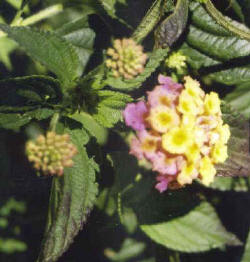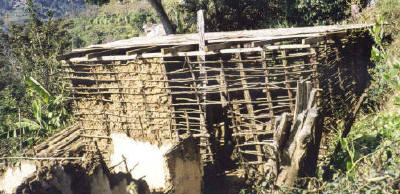
Monday, July 1
Lushoto, Tanzania: Lushoto Sun Hotel
The bus ride from Dar to Lushoto illustrates the dramatic difference between the north and the south of Tanzania. The bus is not particularly crowded, and passengers who don't have seats sit on small stools in the aisle. The bus leaves on time, and we travel on sealed road all the way. We feel like we're traveling in the lap of luxury. When we get closer to the Usambara Mountains, the scenery starts to change. The soil is a deep red, and we start to see large tracts of agricultural land, rather than just subsistence farming. We pass massive sisal farms, which stretch for miles and miles. At Mombo, we turn off the main Dar-Arusha road and head into the mountains. The road is still sealed, but is very narrow and starts to twist and turn its way through the mountains until we reach Lushoto.
We're the only mzungu on the bus, and when we get off, we're immediately approached by a guy from the cultural tourism bureau asking us if we want to organize a trek. After getting settled at the Lushoto Sun Hotel and having a fabulous meal at the Tumanai restaurant run by the Catholic Archdiocese (which might have even better than food we had with the Lutherans), we head to the cultural tourism bureau, which offers trips from half day hikes up to three or four day treks. We sign on for a three day trek going from one small village to the next. We pay just $17 each per day for a guide and accommodation.
After organizing our trek and having a look around town, we head down to Lawn's Hotel, a 10 minute walk outside of town. Lawn's claims to be the oldest operating hotel in Tanzania. It's clearly a throwback to colonial times with European furniture, and even an oriental carpet. The hotel is high on a hill with a view of the surrounding town. We sit outside enjoying the view while listening to what sounds like band practice Xðfrom down below.
Tuesday, July 2
Rungwe, Tanzania: Convent
Our guide on the trek
turns out to be a young woman in her early 20's who speaks perfect English.
I'm very excited to have the opportunity to speak with an Africa woman.
While we've talked with lots of African men about a wide variety of subjects, so
far, most of the African women that we've had contact with have been waitresses,
store clerks, and hotel employees, and our conversations have been very limited.

As we set off, the skies look threatening. We head out of town into the hills and Mwisho, the guide, tells us about the culture of the local tribe, the Shambaa. The local villages, which have a population of about 3000, still have a king who governs the villages. While he has no political authority, the king is a well-respected figure, and has been invited to meet with the President of Tanzania. It starts to drizzle, and as we head into the rain forest, it opens up and pours. Luckily we had left our packs in the Tourism office and have only taken our day packs with us. As we pass through the rainforest, one of the most biodiverse places in Africa, Mwisho points out a number of plants that are used for traditional medicine.
 It finally clears up, and we stop
for lunch. I pull out the can of tunafish that I bought in Dar and have
been saving for the right occasion. After lunch, we walk a little farther
to wait for a bus to take us to our destination for the evening. We wait
for a while, probably a half hour or 45 minutes. By this time, we don't
think this kind of wait is unusual at all, but Mwisho is getting very nervous.
Apparently if this bus doesn't come, which is a realistic possibility, we have
to walk an extra 12 miles or so. We decide to keep walking, just in case.
A number of vehicles are heading downhill including several pickups loaded down
with cattle (5-6 in each truck) with as many men sitting in the back with the
cows. As we're walking, we see black and white colobus monkeys swinging
from the trees. Finally, the bus passes. Apparently it was late, and
extremely overcrowded, because it had been broken down the day before. We
scramble on and get packed in like sardines. After a few minutes, we
pass a group of 15 English students who'd been in Lushoto and who were doing the
same trek that we were. The bus is just way too crowded for that many
people with luggage, and it passes them by.
It finally clears up, and we stop
for lunch. I pull out the can of tunafish that I bought in Dar and have
been saving for the right occasion. After lunch, we walk a little farther
to wait for a bus to take us to our destination for the evening. We wait
for a while, probably a half hour or 45 minutes. By this time, we don't
think this kind of wait is unusual at all, but Mwisho is getting very nervous.
Apparently if this bus doesn't come, which is a realistic possibility, we have
to walk an extra 12 miles or so. We decide to keep walking, just in case.
A number of vehicles are heading downhill including several pickups loaded down
with cattle (5-6 in each truck) with as many men sitting in the back with the
cows. As we're walking, we see black and white colobus monkeys swinging
from the trees. Finally, the bus passes. Apparently it was late, and
extremely overcrowded, because it had been broken down the day before. We
scramble on and get packed in like sardines. After a few minutes, we
pass a group of 15 English students who'd been in Lushoto and who were doing the
same trek that we were. The bus is just way too crowded for that many
people with luggage, and it passes them by.
We arrive in Rungwe late in the afternoon and have a short walk to the convent, which we had paid an extra $6 each to stay in, and which turned out to be worth every penny. The convent grounds are beautiful, lined with flowers and a vegetable garden. We're the only ones in the small guest building, which has a couple of bedrooms and a bathroom. The nuns greet us with tea and homebaked bread with jam, and then bring us hot water for bucket baths. After washing up and changing into dry clothes, we went for dinner -- one of the best of the whole trip -- salad, rice, potatoes, very tender and tasty beef, and, for dessert, freshly poached pears in syrup. Much to our surprise and Randy's delight, they even had cold beer. Breakfast was even better: eggs, cooked tomatoes and onions, and another loaf of homebaked bread, which we took with us to use for sandwiches for lunch.
Low point of the day: the outrageous commission charged by the bank in Lushoto (the only bank in town) to change traveler's cheques
Wednesday, July 3
Sunga, Tanzania: Limbe Travelers Camp
The next day we had a relatively short walk to Sunga. We passed through a number of small villages with houses painted with colored earth. Mwisho explained that in addition to cooking, cleaning, bringing water from the well, and tending to the children, the women in these villages were also responsible for painting the exterior of these houses. The paint is earth mixed with water and dyes, and has to be repainted several times a week to keep the color. The houses have all sorts of designs as well as proverbs or holiday greetings that change throughout the year.
In one of the small villages, a woman invited us into her home. The house is much bigger on the inside than it appears. It has one main room that serves as a kitchen/dining room/living room/bedroom, and another room that's just a bedroom. She showed us how they keep the fire going both for heat and for cooking, how they dry maize, and how they're able to store a good deal of stuff in a sort of loft above the main rooms.
Throughout the trip, Randy was fascinated with the construction of the local housing, and on this walk we got to see houses in all the stages of the construction process.
|
|
The finished product |
 |
|
|
|
We arrived in Sunga just as the primary school was letting out. As we got close to the village, we could hear children laughing and screaming, but couldn't see them. Then we looked up, and could see them running down the hill from the school toward the village. Although we had not seen them, as always, they had spotted us. (Of course, it's easy when you stick out like a sore thumb.) As they got closer, we could hear that they were sounding the alarm: Ma-zoon-goo!!! And soon we had every kid in town following us. The ritual began. The kids, very curious but at the same time very shy, would approach us, but when we'd turn around or try to speak to them, they'd turn, run, and scream. Finally, a few of the braver ones started to talk with us. "Good morning, teacher, how are you" is the typical greeting. We had been responding with "Fine, thank you, how are you?" Which, of course, brought the response of "Fine, thank you, how are you?" and the conversation could proceed this way for quite some time. Mwisho told us that the response that they are accustomed to hearing is not "Fine, thank you," but "Sit down class." We tried this a couple of times and got some very big laughs. She also told us that English class is usually in the morning, which explained why "good morning" is used as a greeting all day long. Once the kids got comfortable, all 50 or 60 of them wanted to shake hands or high five, making us feel like minor celebrities.
 In the afternoon, we visited a small village where the
women make pottery by hand (no wheels and no molds). At their
insistence, I tried, unsuccessfully, to make a small bowl. I felt
better, though, because Mwisho's pot came out as badly as mine did. We bought
a couple of little pots and
ashtrays for about 50 cents each.
In the afternoon, we visited a small village where the
women make pottery by hand (no wheels and no molds). At their
insistence, I tried, unsuccessfully, to make a small bowl. I felt
better, though, because Mwisho's pot came out as badly as mine did. We bought
a couple of little pots and
ashtrays for about 50 cents each.
On the way back to our guesthouse, we met some boys playing with tops that they wind up in a long string and fling onto the ground. Then they hit the top with the string and can send it flying several feet and have it land still spinning. As we've traveled, we've noticed the ingenuity of the children (and I'm sure their parents also) to make toys from simple materials that keep the kids entertained for hours and hours. Very common are cars and trucks made from scraps of metal, plastic hoops (probably the tops of water containers) that kids chase with a stick, and soccer balls made from wadded up plastic bags held together with rubber bands.
Back at the guesthouse, we had a fire in the fireplace and just relaxed for the rest of the afternoon. As we were getting ready for bed, I took the kerosene lamp into the bathroom to use the squat toilet and did not even bat an eyelash; that's when I realized that we'd been in Africa for a long time.


